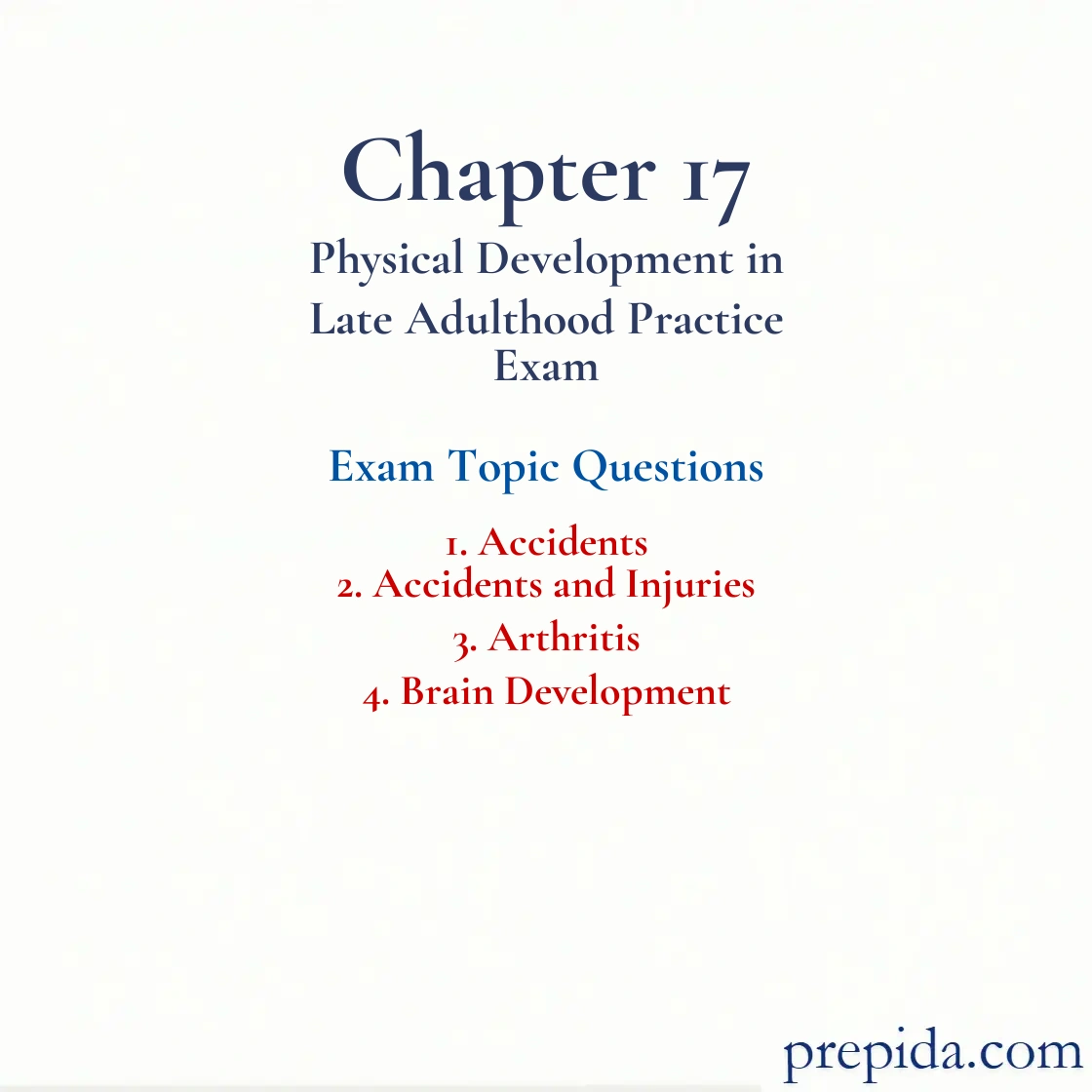
________ are the eighth leading cause of death among older adults.
- Suicides
- Homicides
- Unintended injuries
- Chronic illnesses
________ are the leading cause of injury deaths among adults who are 65 years and older.
- Household fires
- Falls
- Motor vehicle accidents
- Heart conditions
Mrs. Hernandez has considerable pain and inflammation in her wrists, fingers, and knees. It is becoming quite difficult for her to maintain her usual routines as her stiffness increases. Mrs. Hernandez has
- arteriosclerosis.
- diabetes.
- arthritis.
- osteoporosis.
Arthritis: Inflammation of the joints accompanied by pain, stiffness, and movement problems; this disease is especially common in older adults.
Which of the following statements is true of arthritis?
- There are a few known cures for arthritis.
- Exercise is not beneficial for people with arthritis.
- Symptoms of arthritis can be reduced by drugs.
- Symptoms of arthritis cannot be alleviated by reducing weight.
Arthritis: Inflammation of the joints accompanied by pain, stiffness, and movement problems; this disease is especially common in older adults.
The ________ is one area that shrinks more than others with aging.
- prefrontal cortex
- amygdala
- hypothalamus
- premotor cortex
The neurotransmitter ________, which helps control the preciseness of the signal sent from one neuron to another, decreases with aging.
- serotonin
- dopamine
- gamma-aminobutyric acid
- noradrenaline
Severe reductions in the production of dopamine have been linked with
- Parkinson disease.
- Alzheimer disease.
- dementia other than Alzheimer disease.
- brain cancer.
Parkinson Disease: A chronic, progressive disease characterized by muscle tremors, slowing of movement, and partial facial paralysis.
Reductions in ________ have been linked to small declines in memory functioning and to the severe memory loss associated with Alzheimer disease.
- gamma-aminobutyric acid
- dopamine
- acetylcholine
- adrenaline
Alzheimer Disease: A progressive, irreversible brain disorder characterized by a gradual deterioration of memory, reasoning, language, and eventually, physical function.
Aaron is a healthy, 65-year-old man. Compared with his 24-year-old son Harry, Aaron has much less brain volume. Which of the following is most likely the reason for this difference?
- Harry has a lower number of synapses than Aaron has.
- Aaron is experiencing shrinkage of neurons.
- Harry has reduced tree-like branching in the dendrites of his brain.
- Aaron has a thicker corpus callosum than Harry has.
Neurons: Nerve cells that handle information processing at the cellular level in the brain.
Which of the following is a primary reason for the lowered brain volume of older adults compared with that of younger adults?
- increased growth of dendrites
- increased length and complexity of axons
- lower numbers of synapses
- lower number of neurons
Neurons: Nerve cells that handle information processing at the cellular level in the brain.
With age, ________.
- brain weight decreases; brain volume does not decrease
- brain volume decreases; brain weight does not decrease
- both brain weight and brain volume decrease
- neither brain weight nor brain volume decreases
A study by Shan and others found that the volume of the brain was ________ in older adults than in younger adults.
- 20 percent more
- 15 percent less
- 25 percent less
- 10 percent more
Which of the following is the region of the adult human brain where neurogenesis has been documented?
- amygdala
- hippocampus
- prefrontal cortex
- hypothalamus
Neurogenesis: The generation of new neurons.
Identify the region of the human brain in which neurogenesis has been documented in adults.
- amygdala
- hypothalamus
- prefrontal cortex
- olfactory bulb
Neurogenesis: The generation of new neurons.
On average, the adult brain loses ________ percent of its weight between the ages of 20 and 90.
- 1 to 5
- 5 to 10
- 10 to 20
- 20 to 30
The ________ is involved in smell.
- hippocampus
- amygdala
- olfactory bulb
- prefrontal cortex
Amygdala: The region of the brain that is the seat of emotions.
The ________ is involved in memory.
- hippocampus
- amygdala
- prefrontal cortex
- olfactory bulb
Memory: A central feature of cognitive development, pertaining to all situations in which an individual retains information over time.
According to a study by Coleman that compared the brains of adults at various ages, from the 40s through the 70s, the
- growth of dendrites increased.
- growth of dendrites decreased.
- number of axons increased.
- number of neurons increased.
Neurons: Nerve cells that handle information processing at the cellular level in the brain.